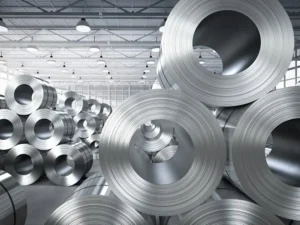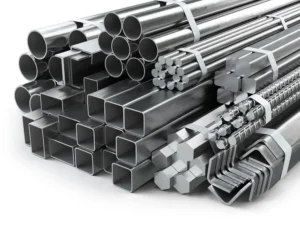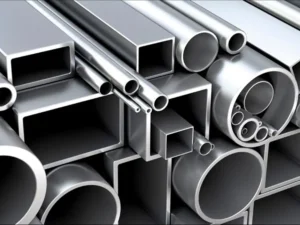Introduction
Steel has many applications in various daily lives. From single utensils in the kitchen to airplane manufacturing systems, they deploy the unique features of steel. But there are different types of steel, such as stainless steel or alloy steel. Alloy Steel vs. stainless Steel can be a tough competition for applications. But don’t worry; you can differentiate them based on their features. In this article, we will have an in-depth comparison between stainless steel and alloy. Let’s talk about the different physical, strength, and applications of both materials.
Related: Key Differences: Mild Steel Vs Carbon Steel
What is Alloy Steel?

Usually, steel has two main components: carbon and iron. An alloy steel is a combination of steel with other metals. One of the top choices is chromium. You can also find other elements, such as manganese, molybdenum, and nickel.
All these metals share different features that give steel other properties. For instance, chromium enhances the strength while manganese improves the ductility of steel.
Types of Alloy Steel

There are two primary groups of alloy steel. These include:
Low Alloy Steel
Low alloy steel has a lower content of the additional elements in the steel. It is almost 5% or less of chromium, copper, or other metals than the total steel content.
High Alloy Steel
Whenever the additional metal content exceeds 5% of the total, it is classified into high alloy steel. The metal remains the same, such as chromium, copper, or other materials.
What is Stainless Steel?

Stainless steel comprises the steel with 10.5% chromium metal. Adding chromium improves the resistance against corrosion and provides better features.
It is one of the most popular options, holding applications from your kitchen to medical equipment.
Types of Stainless Steel
Stainless steel has five fundamental types. It depends on the content of additional metals added to the steel content. Here are five main types.
Austenitic Stainless Steel
This steel type is prevalent because of its excellent durability and corrosion resistance. It comprises 17-25% Chromium and 8-20% Nickel content compared to the overall proportion of steel. 304/304L is the best example of this steel type.
Ferritic Stainless Steel
Ferritic type of steel contains 10.5% of chromium content. It has a high resistance but less durability compared to various other types. Typical examples are 430.
Martensitic Stainless Steel
Martensitic can withstand heat treatments. They share 12 to 16% Chromium and 0.08% to 2% carbon content. Common examples include 410 and 410C.
Duplex Stainless Steel
18-29% Chromium and 3-8% Nickel make up the main content of duplex stainless steel. You can also find various other elements, such as nitrogen or molybdenum. It is firm and durable.
Precipitation-hardening stainless steel
12-16% Chromium, 3-9% Nickel, and other elements such as aluminum make up most of this stainless steel form. It is also strong, durable, and ductile.
Alloy Steel vs Stainless Steel; Detailed Comparison
Mechanical, chemical, and physical aspects of both steel parts have various things different. Let’s compare all the features and see which is better for you.
| Feature | Alloy Steel | Stainless Steel | Winner |
| Tensile Strength | 758-1882 MPa | 515-827 MPa | Alloy Steel |
| Hardness | 200HB to 600HB | 150HB to 300 HB | Alloy Steel |
| Ductility | High | Low | Alloy Steel |
| Impact Resistance | Higher resistance | Lower resistance | Alloy Steel |
| Fatigue Strength | High | Depends on the Grades | Depends on Grade |
| Corrosion Resistance | Low | High | Stainless Steel |
| Heat Treatment and Fabrication | Easy Fabrication | Almost Easy fabrication | Tie |
| Applications | Construction, automotive, airplane industry | Kitchenware, medical, automotive | – |
Tensile Strength
Tensile strength shows how much power you can apply before breaking the metal into pieces. A high tensile strength shows a high power to withdraw harsh conditions. Such metals are often long-lasting and provide applications in industrial sectors. Let’s compare both stainless steel and alloy.
Alloy steel has a high strength and can withstand higher power. The strength rating is 758-1882 MPa. It is more than stainless steel. Therefore, you can explore more applications in different fields.
Stainless steel gives good competition to alloy steel. With a rating of 515-827 MPa, it can still bear much of the tensile force. Owing to its high tensile strength, it is very prevalent for various applications.
Hardness
Hardness defines the resistance to wear and tear. A higher hardness shows a longer life and a better response to the external force. Usually, additional elements help determine the hardness.
Alloy steels are the winners at this point. They have a higher hardness of 200HB to 600HB on the Brinell scale. It is more than the stainless steel. All thanks to the less than 5% alloy materials in the alloy steel.
Stainless steel has a good hardness but not higher than the alloys. 150HB to 300HB is the typical hardness and 8th rank on the Moh’s scale. It is harder than aluminum but less than steel alloys.
Ductility
Have you ever seen the sheets of metal? The flexibility helps define the sheet-making strength of a metal. In short, ductility is the elongation of steel without breaking. Heat treatment helps elongate the metal and make the sheets.
Alloy steels have various elements that help improve their ductility. They are more sustainable for all applications involving elongation applications. They also make the delicate parts of the metals.
Compared to the alloy steel, stainless steel has less ductility. Hence, it is more suitable for other applications.
Impact Resistance
Shock or enforcement are common phenomena in the metal industry. The hardness defines the impact resistance. We already know the winner at this point.
Alloy steel has a higher hardness and can deliver more impact resistance than stainless steel. That means a higher force can’t damage the alloy steel quite quickly as it can do to the stainless steel.
On the other hand, highly high forces can rupture the stainless steel quite easily. Therefore, stainless steel can easily be deformed with immense forces.
Fatigue Strength
In the fabrication and stamping process, metals undergo different cycles of stress. The highest number refers to the fatigue strength. A higher fatigue strength indicates it can face more stress.
At this point, steel tells a different picture. Alloy steel 316L has a higher fatigue strength. It can resist up to 146.45Mpa.
On the other hand, stainless steel has a lower strength. However, some duplex-grade stainless steel has a higher fatigue strength than alloy steel.
Corrosion features
Rust is a significant issue when it comes to the iron. The oxidation of the metal causes corrosion and deteriorates its performance. Steel has redefined the industry due to its high corrosion features. But it varies from one alloy steel to stainless steel.
Alloy steel corrosion features change from one to another. Those alloys which comprise the chromium have a higher corrosion resistance but less than the stainless steel.
Stainless steel comprises the chromium metal. The sole purpose of adding chromium is to prevent oxidation and keep corrosion miles away. That is why stainless steel has a higher corrosion resistance than any steel alloy.
Heat Treatment and Fabrication
Heat treatment can either increase or decrease the features. It all depends on the different grades and composition of the steel. Some grades have a higher power and undergo better resistance to the deformation. Moreover, heat treatments and fabrication involve various components at this point. These include:
- Weldability. It refers to the welding power of the metals.
- Machinability. It is the fabrication process that involves metal cutting with CNC machines.
- Formability. It refers to the capacity at which metal deforms but not damages.
Alloy steel has a good weldability. But, it depends on the grade and chromium composition, which imparts good oxidation layers. It had a higher machinability and formability.
On the other hand, stainless steel has good weldability. Machineability is less compared to alloy steel. While you can rely on the formability depending on the grade, you are deploying for your goals.
Applications
Whether stainless steel or alloy steel, you can find tons of applications in your surroundings. Many household products deploy stainless due to its corrosion-free and long-lasting durability.
Alloy steel has applications in the following fields.
- Construction: Bridges, buildings, and pipelines.
- Automotive industry: Gears, axles, and crankshafts.
- Aerospace industry: Landing gear and turbine blades.
- Tool making: Drills, saw blades, milling cutters.
- Oil and gas industry: Pipelines and valves.
Stainless steel is used in the following industries.
- Kitchenware: Cutlery, cookware, and dishes.
- Architecture and construction. Building facades and handrails.
- Medical equipment. Needles, Blades, Scalpels, Endoscopic Tools
- Automotive industry. Exhaust systems, body panels.
- Chemical and petrochemical industry. Lining reactors and Storage tanks.
Endnote
Stainless steel is equally crucial as alloy steel. Deciding on features can turn out to be the wrong deal. But whenever you need to focus on one, robustness, flexibility, and physical properties are necessary. Look for the unique features and decide on the better one.
If you need top-quality Alloy Steel or Stainless Steel, HXSCO is there. We have years of experience in manufacturing world-class quality steel. Affordable prices and guaranteed quality elevate your product’s durability!
